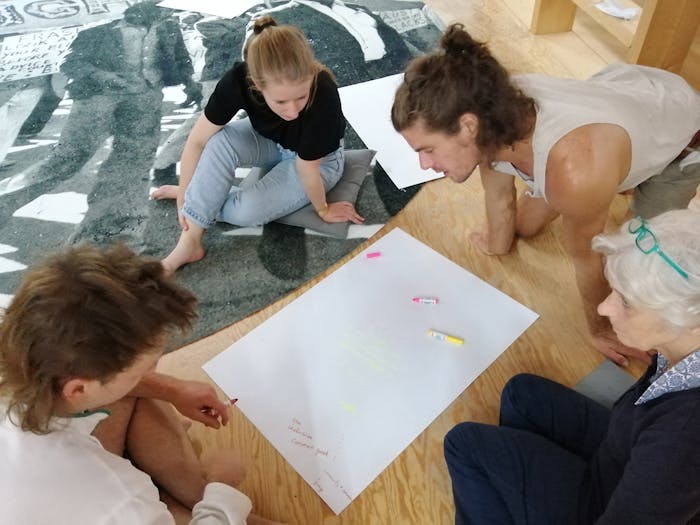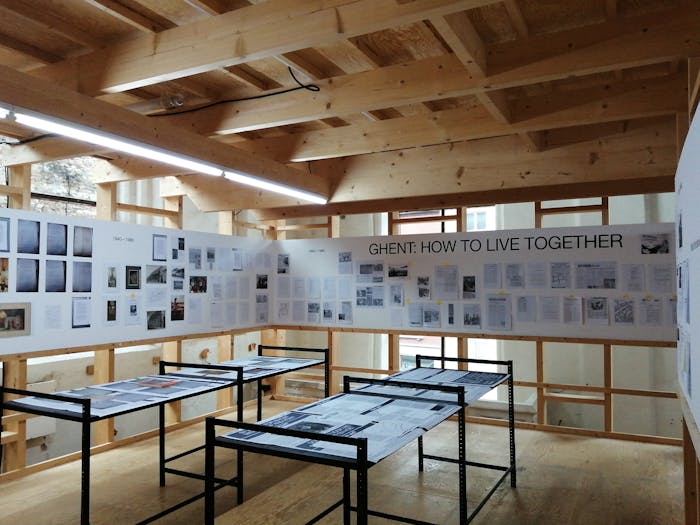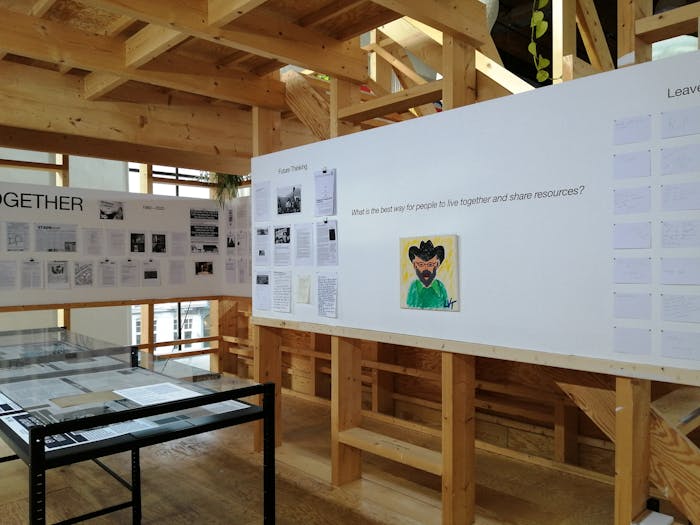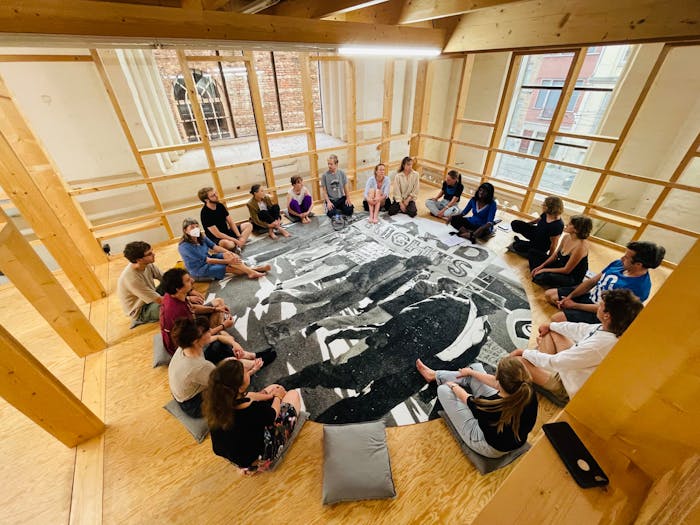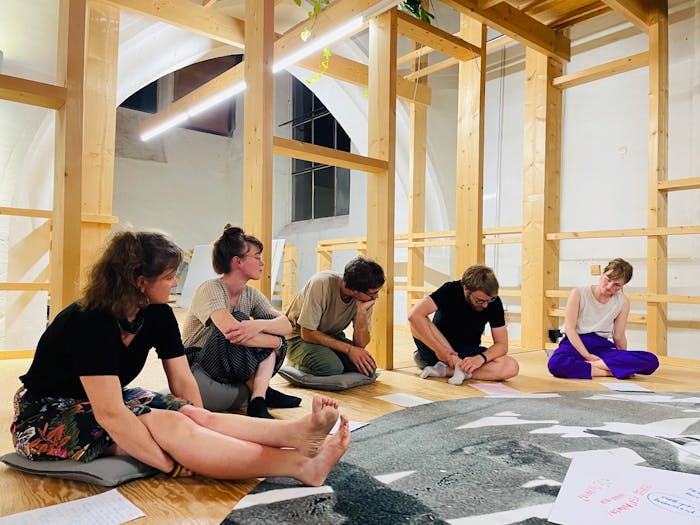Grace Ndiritu (1982) is an artist of British-Kenyan descent whose practice spans a variety of media. For long she has been exploring the artistic potential of alternative rural lifestyles, post-hippie culture, shamanism, interdisciplinarity and political activism. Her work is currently on display at Nottingham Contemporary with Céline Condorelli and Femke Herregraven. For her project at Kunsthal Gent, Ghent: How to Live Together, Ndiritu explores how the site of the former monastery can serve as a model for commoning when the users of the site have conflicting interests. Pieter Vermeulen talked with Ndiritu about the project in Ghent and her practice.
Pieter Vermeulen: Your current project at Kunsthal Gent, Ghent: How to Live Together, deals with both the history of the Caermersklooster and its current situation. Could you elaborate on that?
Grace Ndiritu: In 2018, when I started working on COVERSLUT©, my fashion and economic project in Ghent, I went to the opening of Kunsthal Gent. Danielle Van Zuijlen, the artistic coordinator, told me about an issue they were having in the building, about a corridor which is owned by the Province, but it's in a part of the building that is owned by the City of Ghent. So that was my first indication about there being some kind of serious dispute in the building over property and land. And then, over the years, I've heard bits and bobs about that history. I've also met previous Pandinists from the 1970s who have actually lived in Het Pand. Last year, when the development program at Kunsthal Ghent came up, I thought it could be a really interesting time to explore that and try to do a multilayered project incorporating social practice, archival research and exhibition display.
PV: The project consists of several chapters, each involving different people. How did it play out so far?
GN: I collaborated with Jubilee because they have been working on legal contracts in their project Caveat. I designed the whole project to be a kind of 'season'. I called it a Season of Truth and Reconciliation. It deals not only with the building, but also with the past inhabitants and the present inhabitants. Since January, a legal expert Julie [Van Elslande, PV] and I have been researching the history of the building as well as investigating the current situation. We spent many months phoning the City, the Province, the Dekenij [deanery, PV], WoninGent, Fernand Huts and other stakeholders who have an interest in the site. We eventually got to speak to Miss Miyagi [a real estate development design team hired by SOgent, a department of the City of Ghent, PV], who were asked to actually do design proposals. We were lucky because we got to speak to Miss Miyagi in February, so we got to see some of the proposals before anybody else; Some of their ideas were to turn Het Pand into a hotel and a conference hall. But it was a weird situation to be in because obviously, they were asking our advice, but we were wondering why this information was not made public? Parallel to this work and unknown to us, there was a group of young artists, the 'Pandemists', who decided to squat the building. That changed the project in terms of attention because once the Pandemists went into the building, a lot of press came. But we always made a clear distinction that we were not Pandemists. The idea of my project was to be more of a neutral party in the whole debate because I am interested in terms of reconciliation. Talking about my own family history, my mother was an activist. I grew up going to demonstrations, anti-apartheid, pro-multicultural, and so on. My mom then went to study Truth and Reconciliation when I was 10. I have a real belief in that way of working so I designed a program that has these different elements in it. My goal was not to just have a public debate—in fact, the public debate aspect of the project is the last event in the season. Instead, I started with something called A Therapeutic Townhall Meeting, as a way to bring different stakeholders together, from the Dekenij to the Pandemists, Miss Miyagi, people from the Province and obviously the general public. It was not so much about debate as about looking at the issue in a different way. We sat on a carpet that I had made from a new series of textile artworks I call Protest Carpets, works of art that can also be activated by events. And so, at this event, I led participants through different bonding exercises like meditation, wordplay games, but also writing love letters to an enemy. For example, the Pandemists would write love letters to the developer. But by doing this, you saw how difficult it is to write something positive to someone you think is ideologically different from you. It was a very powerful exercise in community building, with different people from different ages, and a great way to begin the project.
All the pressure from the Pandemists and my project since April made SOgent decide to finally present Miss Miyagi's findings to the public in October. At first, they asked Kunsthal Gent whether they could present it there, but, for me, it had to be contextualized within the Season of Truth and Reconciliation. SOgent was very sceptical about this, so they decided to do it at De Centrale and invite everyone there instead. Because even though the decision to sell the building has already been made, no one's going back on that decision, it is still important to discuss who to sell it to and what to do with the building in the meantime.
So that was the second event. I called it Findings: A Night of Revelations. It was nice because a lot of the people who came to the first event at Kunsthal Gent were also there, including more people from the Patershol neighbourhood, including Julie and I, who went there to ask questions. I presented the project and asked the two city councillors why it is taking them so long to present the findings that we saw in February, and how they're going to change things.
The third event was called Contested Land and Indigeneous Land Rights, organized together with Art Cinema OFFoff. I chose three films that I thought were complex in the sense that they layered this issue. Because it's not an easy issue in terms of what is contested and what isn't. I showed a silent film from the 1970s of hippies who used to live in Het Pand. Not many people had seen that as it was coming from the archives of the Huis van Alijn a local msueum in Patershol. Then I also showed a documentary titled Water Warriors, about First Nation groups in Canada, who have been fighting to get their water rights and to stop energy companies from taking over. The last one was The Last Movie (1971) from Dennis Hopper, which is quite a bizarre, controversial film. It's like a film within a film, but it's really important to see how issues of indigenous and land come into it. This was a kind of a surreal film screening night with, of course, a different audience because of OFFoff.
The next event was called Local Knowledge night. I asked three local residents who have been involved in Het Pand since the 1950s until now. The first one, Norbert Detaeye, his family grew up there. His grandmother lived there in the 1920s-30s. His mother lived there, he lived there, and he still lives in the neighbourhood. He has basically lived there all his life. Then I asked Luc Rogiest, an original Pandinist from the 1970s. He got evicted in 1982 along with everybody else. Once the building turned into social housing in the 1980s, residents came to live there. One of them was called Emily De Vlam. She's a current Pandemist and the longest standing resident. She's been there all the time and raised her whole family there. That was a nice evening, a local community event hosted both in Dutch and English.
For the fifth event, we did a Holistic Reading Room which involved a group reading of the Italian philosopher Giorgio Agamben's book on the law of living together: The Highest Poverty: Monastic Rules and Form-of-Life, interrupted by short breaks of meditation led by myself. The night also involved looking at the first inhabitants of the buildings, the monks. It turns out that when the monks lived there, after the French Revolution they began to have issues to do with property. So they had come up with different schemes about trying to sell parts of the building to different owners, and they already had a property developer at that time sending them letters, which we found in the archive, giving them advice about how to split the building up into lots. Before that time, they did not consider themselves as property owners, only that the land was for common use as it was God's land. Over the last twelve months, we found a lot of intriguing historical information that is now in the archive I designed upstairs at Kunsthal Gent. It covers the history of the building from the 13th century until today. It incorporates not only historical letters and maps and texts but news clippings from the 70s onwards, my email correspondence with all the stakeholders while doing this project, and so on.
PV: You also released an open call for people to contribute to the archive?
GN: Yes. I designed a section in the archive called Future Thinking where I put more information about commoning and what's going on around the world in indigenous groups with land rights struggles. But there is also this bit where I asked people 'what is the best way for people to live together?' You can leave your answer on a piece of paper and leave it there.
PV: Could you explain this concept of commoning a bit more, and how it is related to your current project?
GN: On the 10th of December, we're going to have a public debate called Commoning, Property Law and Indigenous Land Rights in the Belgian and Global Context. Normally what happens with an issue like this that is so hot and polarizing, is that people just want to argue with each other and stand their point. What's much more important is the idea of active listening, a form of nonviolent communication. So, for the last event, I've asked a historian, a legal expert, and an urban developer, to give inspirational examples of what's going on in the world. Because the debate around what to do with patrimonial buildings is going on everywhere in the world. I see Ghent as a test case, and perhaps also a model for other places in Belgium in the future, something they can learn from if it is resolved in a peaceful way, which it can be if the City and the other stakeholders (including the public) have an open and transparent dialogue. But it should always be put back in the global context. Rafaël Verbuyst will give a talk about what's going on in South Africa, where there have been similar issues with patrimonial buildings left over from colonialism and apartheid.
For me, the most important issue is the connection between environmental justice, land rights, and, say, the sponsorship of museums by oil companies. So the whole debate around stolen objects, stolen land, stolen climate—a great slogan from London activists BP or not to BP—shows how these three subjects intersect. I see commoning as a way where that intersection happens. As far as I've understood, commoning is not only about common goods but also about shared resources, and how you work together. There are initiatives like the Community Land Trust, which already exists in Brussels and is trying to gain a foothold in Ghent as well. A young urban developer, Jorik De Wilde, will be giving those kinds of examples. And then Marie-Sophie De Clippele will be talking about nature's rights in relation to commoning. That's what the public debate will be about. We already know that people are really going to want to argue about Het Pand. I will be the moderator, but I will try to focus the issue on a more global context because there are very inspirational examples to be found in Italy, Chile, New Zealand, etc.
PV: As an artist, aren't you afraid of getting too caught up in local political issues?
GN: Not really, because I still think of it as an art project. Growing up in an activist household, I'm always wary of calling myself an activist. Real activists often risk their lives. I'm not gonna risk my life for this. I'm also very visual, so you can see that reflected in the look of the project, for instance, all the black-and-white images that I picked or the particular design of the Protest Carpets that I made. Even the archive with the timeline has a specific Joseph Kosuth-type of aesthetic.
PV: How does How to Live Together tie in with your artistic practice on a more general level?
GN: I work in so many different mediums, whether it's painting, video, film, text, fashion or social practice. I think this particular project is connected to bodies of work like Healing The Museum, that has been going on for many years since 2012. But also, it's connected to The Ark: Center For Interdisciplinary Experimentation, for which I invited people to live together off the grid and start a community. It can also be related to the long-term research I did for the Goethe Institute, about the restitution of objects. When I was invited to the Museum of Anthropology in Vancouver and Argentina, I worked with various indigenous groups. So you could say that Ghent: How to Live Together is a project that brings together many of my interests, but it's in the form of social practice and exhibition display. I've been doing a lot of social practice the last seven years, but I might start to take a break from it and again focus more on objects, film, or textiles. But it's hard to choose, there are always so many interesting things to do in life. (laughs)
